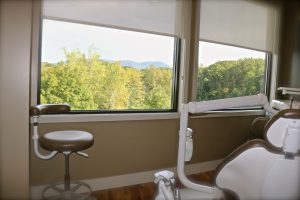Header logo
header top contact widget
Dental Fears
Dental Fears And Periodontal Disease – Likely Partners.
Posted on Mar 01, 2018 by William J. Claiborne, DDS MS
I’m not afraid of spiders. I don’t necessarily welcome them into my home but seeing one doesn’t ‘freak me out,’ either. However, I know several people who have a fear of spiders that goes beyond simply feeling creeped out by them.
Most of these individuals aren’t certain when or why their fear of spiders began. They just know they have it. For some people, it’s the same with fear of dentistry. While some adults can track back to precisely when and why their dental fears began, others aren’t quite sure.
In a dental office, some people react negatively but uncontrollably to sounds, smells and sights. However, when dental fears exist because of a traumatic experience in a dental chair (often as a child), we know the element of trust between the individual and his/her dentist was broken.
A dentist who continues a procedure on a patient while the patient is uncomfortable – whether an adult or child – can create an everlasting fear associated with dental visits. This moment is forever in the corners of a patient’s mind, evoking anxiety or fearful sensations every time a dental visit is considered. It’s the body’s way of triggering its ‘fight or flight’ response. Like shivering in the cold, it’s a reaction that is not easily controlled.
Although we cannot erase traumatic moments from one’s subconscious, we can help patients get past their fears and achieve healthy, confident smiles. And, the need for a healthy mouth is rising to the top as one of the most important aspects of having good, overall health based on a remarkable amount of research.
Research has found that certain strains of oral bacteria from gum disease create reactions in the body that can trigger systemic inflammation. Thus far, research findings have shown a correlation between periodontal disease bacteria and some cancers (including pancreatic and lung), Alzheimer’s disease, pre-term babies, heart disease, stroke, diabetes, arthritis and erectile dysfunction (ED).
As if all that weren’t bad enough, one study suggests that gum disease relates to a reduction in one’s quality of life: “Periodontal disease has been linked to lower quality of life.” “Quality of life encompasses several domains, including psychological functioning and social relationships among others. Oral health-related quality of life has been shown to be reduced in patients with periodontal disease.” (https://www.hindawi.com/journals/prm/2017/5491923/)
While estimates show about 75 percent of American adults have some degree of dental fear or anxiety, over 47 percent have some level of periodontal disease. As a periodontist, both are alarming numbers. Nearly half our nation is walking around with a potentially life-threatening disease in their mouths. Yet, many are unaware of its presence.
The symptoms of gum disease begin silently. When they do emerge, some people ignore them, such as seeing blood in the sink when brushing. There is a misconception that this is a sign of brushing thoroughly. (Wrong! See below for helpful tips for proper brushing.*) Other symptoms, such as sore, swollen gums and frequent bad breath may be assumed to be temporary problems.
If dental fears or anxiety have kept you from regular dental checkups for a year or more, it would be rare to NOT have some level of gum disease. Quite frankly, some people with high fear levels avoid seeing a dentist for decades. Those visits are vital in one’s ability to have healthy gums.
While twice daily brushing and daily flossing are necessary components for having good oral health, the routine alone isn’t enough to combat a number of additional factors that make one vulnerable to the disease.
For example, snacking on sweets or carbohydrates super-charges the oral bacteria in your mouth. And, these between-meal munchies set off an added acid attack in the mouth (as occurs any time we eat or drink as part of the digestive process). Couple this oral acid with sugar-loving bacteria and perhaps the extra acidity of a cola or catsup and WHALLAH you have a perfect recipe for destructive bacteria in the mouth.
What creates even more vulnerability is the lack of proper brushing techniques. A number of people swipe a toothbrush over easy-to-reach teeth, do a quick swish, and they’re done. And, as a study by Delta Dental revealed, only 7 out of 10 adults are brushing twice a day. This means that 30 percent aren’t brushing enough. (https://www.ada.org/en/publications/ada-news/2014-archive/october/survey-finds-shortcomings-in-oral-health-habits)
Like anything, using proper measures makes all the difference.
* Begin with a soft to medium bristle toothbrush and a fluoridated toothpaste. Pretend your mouth is divided into four sections and spend 30 seconds in each area. Swirl the toothbrush around all sides of your teeth, including the tops that have deep pits and crevices where bacteria can hide.
Hint: if your bristles are bent to the sides after a month or so, you’re pressing down too hard. Lighten up so the tips of the bristles swipe over the surface.
Floss daily to dislodge food particles caught between teeth. These bits can rot quickly and add to bacteria levels in the mouth. What’s that? Flossing is a pain? Electronic water flossers are affordable, easy to use, and do an effective job.
Once your teeth are brushed, brush the tongue to remove oral bacteria that burrow into its grooves. Be sure to reach the back portion where the majority exist. Swish and spit several times.
Hint: Consider purchasing a toothbrush that has a tongue scraping section (typically the reverse side of the bristles). For some people, this is more comfortable than brushing.
If you are one of the 75 percent who have dental fear or anxiety OR one of the 47 percent who have some type of periodontal disease OR – even worse – have BOTH, please call us to schedule a consultation to discuss restoring the health and appearance of your smile.
In addition to providing a specialized environment for treating all stages of gum disease, we are also experienced in helping fearful adults achieve good oral health and smiling confidence. We offer a respectful, compassionate staff, an inviting office setting as well as Oral and I.V. sedation (twilight sleep), if desired.
Call 828-274-9440.
Dental Fear Can Lead To Lost Teeth.
Posted on Jan 23, 2018 by William J. Claiborne, DDS MS
There are many reasons that adults lose teeth. Poor oral hygiene, accidents and gum disease can all result in the loss of natural teeth. Yet, the most unfortunate reason, as far as I’m concerned, is dental fear.
Having a fear of dental visits affects over 70 percent of American adults by some estimates. When people are afraid of going to the dentist, they often do not receive the regular care necessary to maintain a healthy smile.
While twice daily brushing and daily flossing are beneficial in having healthy teeth and gums, those 6-month checkups provide a ‘clean slate,’ of sorts. During these visits, the hygienist is able to remove tartar (or calculus) that has built up from accumulated plaque.
Tartar is actually a hardened mass of oral bacteria that attaches to teeth. It eats away at healthy tooth enamel and gum tissues. As the bacteria mass thrives and reproduces, the gum tissues become inflamed. This is the beginning of periodontal disease, which is the nation’s leading cause of adult tooth loss.
In one study published by the Dental Research Journal, nearly 59 percent of 473 adult participants were found to have dental fears. The study included males and females of varying ages and education levels. Although females presented a higher likelihood for dental fear, there was very little difference elsewhere. What did stand out, however, was how many had experienced traumatic dental episodes. (https://www.ncbi.nlm.nih.gov/pmc/articles/PMC4432608/)
As a periodontal specialist, I have advanced training and experience in the diagnosis and placement of dental implants. Thus, over the years, I have treated a large number of adults who have lost natural teeth and wisely chose to replace them with dental implants.
However, when an individual loses a tooth (or teeth) because they avoided dental care due to fear, it’s a pretty big task for many to set those same fears aside in order to go through a dental procedure that is surgical in nature. So, how do they do this?
In our office, we have found the best results for fearful patients is to form a relationship that is built on trust. Our patients come to feel assured of knowing our commitment is to create a pain-free environment, with oral or I.V. sedation (‘twilight sleep’) available, if desired.
For some patients, they feel more relaxed after beginning with a conversation in our consultation room. This room is removed from the clinical side of the practice where we sit in comfy chairs and discuss specific needs and goals. We take the time to answer questions thoroughly and can recommend comfort options.
For most, after their first appointment, they feel more relaxed. Others need several visits to realize that dentistry doesn’t have to hurt. Still others can’t help but have anxiety during their dental care and we understand this. Every person is different and we try to tailor the pace and the comfort options according to each one’s need.
If you’ve lost teeth because you’ve found it difficult to have regular dental care, the solution may be as close as our consultation room. We will make this visit as relaxed as possible so you can decide if we are the right dental team for you.
It may also be helpful to speak with some of our once-fearful patients who now have healthy, confident smiles. Ask to be put in touch with some during your consultation to have a ‘first-hand’ understanding from people with similar issues.
Call 828-274-9440 to schedule a consultation.
Dental Fear? We Provide Patient Comfort In Many Ways!
Posted on Oct 18, 2017 by William J. Claiborne, DDS MS
I have a friend whose wife is a notorious backseat driver, and she freely admits it. Her husband, actually a good driver, has become used to her ‘guidance’ when they’re on the road. She explains it like this: “When I see brake lights suddenly appear in front of us as we’re going seventy miles an hour, I don’t know that his foot is on the brake pedal, ready to respond. All I know is the urge inside of me to warn him. He knows I can’t help it.”
I agree. We all react to certain things automatically. When some people see a spider for instance, they may become fearful and want to flee. Other people react to seeing a spider by rolling up a newspaper, ready to eliminate the intruder.
When it comes to dental fear, different people have different levels. Some of our patients are very relaxed in our office, from the moment they walk in and throughout treatment. Others are fine until they are seated in the treatment chair. Still, others are nervous and uneasy the entire time.
Periodontal (gum) disease is the result of an accumulation of oral bacteria. It is also the leading cause of adult tooth loss. As a Periodontist, I find that most individuals have developed gum disease because they were too afraid of having regular dental care. Many avoid going to the dentist for years, only ‘giving in’ when something becomes so painful they can no longer delay treatment.
Dental fear and anxiety are often the result of an unfortunate experience in a dentist’s office that made the person feel out of control and trapped. I know this can go deep. I’ve heard patients tell how a dentist continued to work on them even when they’d told him or her they were not numb. I’ve heard patients tell me about being held down in a treatment chair as a child. And, I’ve heard patients tell me they have no idea where their fears came from, yet smells and sounds trigger sweating or a more rapid heartbeat.
If you experience these feelings associated with dental visits, there is nothing ‘wrong’ with you. It’s likely your individual response to something that makes you feel vulnerable because you’ve either heard people relay experiences of discomfort or have experienced it yourself, it’s normal to anticipate pain – sometimes even before being touched.

Get pampered in our Reception area.
Perceived pain can be just as real to some people as actual pain.
In our office, patient comfort is a priority at every visit. We have even designed our reception area to pamper you from the moment you enter. Patients in this area can enjoy a selection of gourmet coffees, cable television and WIFI connection. The seating is comfortable and our front office staff are attentive to your needs.
We offer a private consultation room for patients as well. In this room, we can discuss your treatment and answer your questions in a comfortable setting. This allows patients to become better informed about their treatment needs and options versus communicating while they are seated in a treatment chair.

Enjoy beautiful, relaxing views from our surgical suite.
Our surgical suite offers a rather unique setting for a Periodontal office. A large window provides beautiful mountain views, very soothing to our patients. In addition, we offer oral sedation as well as I.V. sedation (twilight sleep) for most procedures, if desired.
Oral sedation is a pill that helps patients relax. It also has an amnesiac effect, leaving most with little or no memory of treatment afterward. I.V. sedation places the patient in a deeper sedative state, also erasing memory of the procedure. It is administered by a doctor of anesthesiology for optimal comfort and safety. With both, patients are monitored with advanced safety equipment throughout treatment.
Our entire staff provide a unified team, each bringing a sincere level of compassion and commitment to excellent care. While the doctors involved in your care are top-notch, I must admit that our staff are the pros at making our patients feel truly pampered.
When patients realize that our goal is to provide exceptional care in TOTAL comfort, they relax. When they experience this, they relax even more. When they experience this more than once, a sense of trust is born. When patients trust us, they feel they no longer need to avoid dental care. Like everyone, fearful patients desire a healthy, confident smile. Once the obstacle of fear is removed, their ability to achieve that is greatly heightened.
If you or someone you know has fear that has prevented needed or desired dental care, schedule a consultation appointment. This will take place in our private consultation room. Here, we can discuss your needs and concerns and have your questions answered thoroughly. From there, you can determine what pace is best for you.
Call 828-274-9440 to learn more. Our friendly telephone staff will make you feel good from the very beginning!
Before & After Sedation Instructions
Posted on Oct 04, 2017 by William J. Claiborne, DDS MS
At Biltmore Periodontics, we pride ourselves on providing optimal safety and comfort to our patients, for every appointment and regardless of the procedure. For some procedures, patients are sedated. Typically, this occurs through “twilight sleep,” which is delivered intravenously (I.V.) by a doctor who is a Board Certified Anesthesiologist, Dr. Brad Stone.
I.V. Sedation places patients in a sleep-like state throughout the procedure. Too, it creates an amnesiac effect so there is no memory of the procedure afterwards. Throughout, the patient is closely monitored by Dr. Stone who uses specific safety equipment. This includes several monitors: EKG (heart), blood pressure, pulse, exhaled carbon dioxide and oxygen saturation.
The sedation process includes instructions both before and after. Dr. Stone will call you prior to your procedure to review your medical history. During this conversation, he will explain sedation and answer any questions.
Following these instructions will help you enjoy a optimal comfort with a quick recovery:
Instructions For BEFORE You Are Sedated
• Eating – No food or any type of dairy product after midnight. In cases scheduled for later the next day, you may be allowed a light meal (example: toast, NO fatty foods) for up to six (6) hours before the procedure. It is critical your stomach is empty by the time of the procedure.
• Drinking – Moderate amounts of clear liquids (water, juice, Pedialyte, Gatorade, soda) can be consumed up to three (3) hours prior to your appointment.
• Attire – Wear loose, comfortable clothing. With colder weather, layering is best. For children, a ‘pull-up’ may help with ‘accidents.’
• Medications – Unless specifically advised, it is recommended to take all medications as prescribed with a small amount of water.
• Transportation – No patient who receives sedation or anesthesia is allowed to operate a vehicle following discharge from our dental office! All patients must have a responsible adult stay with them until they are fully recovered.
Instructions For AFTER You Are Sedated
After you are released from our office, the most important thing you can do is to return home and REST. Giving your body a chance to recover after having anesthesia is best achieved through resting.
Adults
Take your time when moving. Use help or assistance as much as possible. As you move from lying to sitting or sitting to standing, move slowly. If you experience dizziness, lie or sit back down and rest. When climbing stairs, have someone help and assist you. Remember also…
• No driving for the remainder of the day.
• Avoid operation of mechanical or electrical machinery/devices.
• Avoid making any important decisions or signing important documents.
• Avoid consuming alcoholic beverages and/or smoking.
• Avoid any unaccompanied activity.
Children
Children who have been sedated should be carefully monitored by a responsible adult for 4 hours after returning home.
• No climbing, running or riding bicycles for the rest of the day.
Medications: Resume taking prescribed medications once you are drinking fluids. If you receive prescriptions for the procedure, take those as directed. Over-the-counter pain relievers such as Tylenol or Motrin are allowed and may be helpful.
Eating & Drinking: Liquids may be consumed as soon as possible following sedation. Begin with frequent small quantities of clear fluids (such as water, juice and soda). Increase your diet as desired depending on how you feel.
In addition to instructions for sedation, your procedure may include specific guidelines you should follow. We will review those with you carefully. It is our goal to help you achieve an optimal treatment outcome with the highest level of safety and comfort.
Our team is also available to assist you prior to or following any procedure. Call 828-274-9440. If after-hours, our answering machine will provide instructions on how to reach us.
Recent Posts
Categories
Archives
- September 2024
- August 2024
- July 2024
- June 2024
- May 2024
- April 2024
- March 2024
- February 2024
- January 2024
- December 2023
- November 2023
- October 2023
- September 2023
- August 2023
- July 2023
- June 2023
- May 2023
- April 2023
- March 2023
- February 2023
- January 2023
- December 2022
- November 2022
- October 2022
- September 2022
- August 2022
- July 2022
- June 2022
- May 2022
- April 2022
- March 2022
- February 2022
- January 2022
- December 2021
- November 2021
- October 2021
- September 2021
- August 2021
- July 2021
- June 2021
- May 2021
- April 2021
- March 2021
- February 2021
- January 2021
- December 2020
- November 2020
- October 2020
- September 2020
- August 2020
- July 2020
- June 2020
- May 2020
- April 2020
- March 2020
- February 2020
- January 2020
- December 2019
- November 2019
- October 2019
- September 2019
- August 2019
- July 2019
- June 2019
- May 2019
- April 2019
- March 2019
- February 2019
- January 2019
- December 2018
- November 2018
- October 2018
- September 2018
- August 2018
- July 2018
- June 2018
- May 2018
- April 2018
- March 2018
- February 2018
- January 2018
- December 2017
- November 2017
- October 2017
- September 2017
- August 2017
- July 2017
- June 2017
- May 2017
- April 2017
- March 2017
- February 2017
- January 2017
- December 2016
- November 2016
- October 2016
- September 2016
- August 2016
- July 2016
- June 2016
- May 2016
- April 2016
- March 2016
- February 2016
- January 2016
- December 2015
- November 2015
- October 2015
- September 2015
- August 2015
- July 2015
- June 2015
- May 2015
- April 2015
- March 2015
- February 2015
- January 2015
- December 2014
- November 2014
- October 2014
- September 2014
- August 2014
- July 2014
- June 2014
- May 2014
- April 2014
- March 2014
- February 2014
- January 2014
- December 2013
- November 2013
- October 2013
- September 2013
- August 2013
- July 2013
- June 2013
- May 2013
- April 2013
- March 2013
- February 2013
- January 2013
- December 2012
- November 2012
- October 2012
- September 2012
- August 2012
- July 2012
- June 2012


